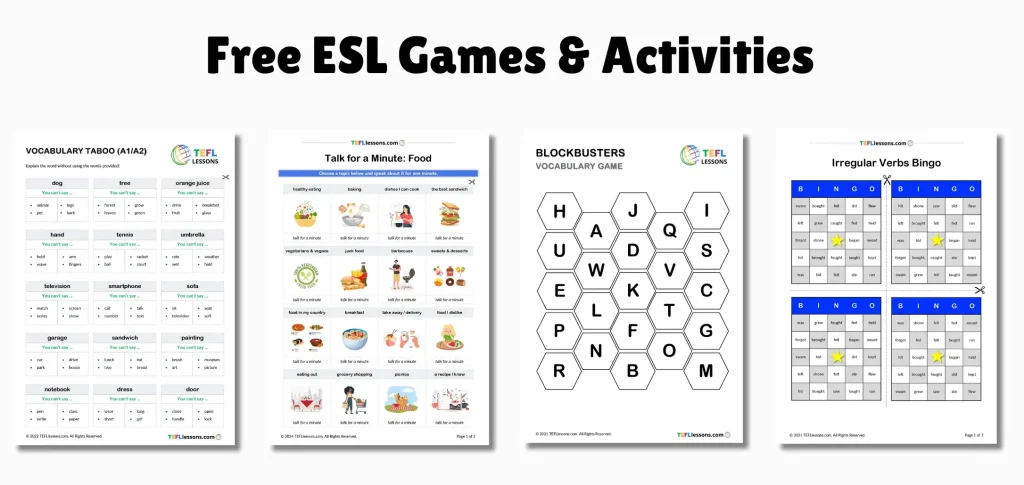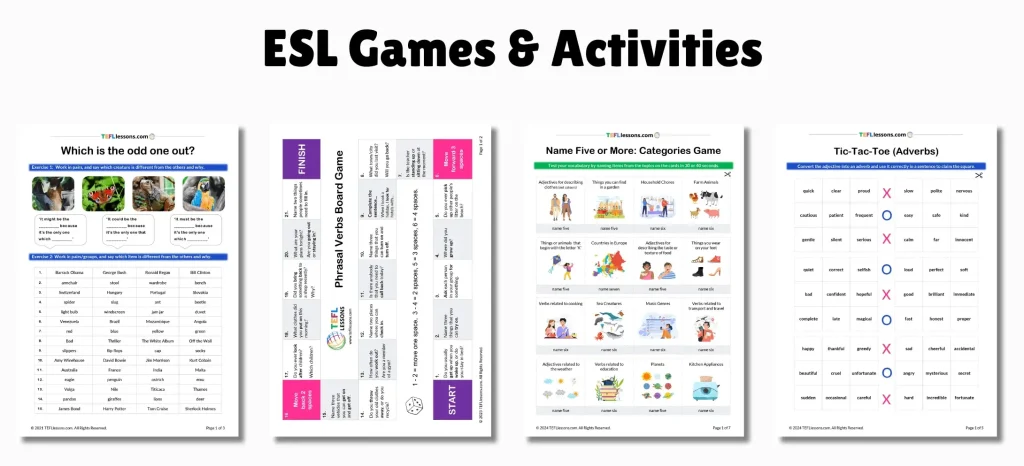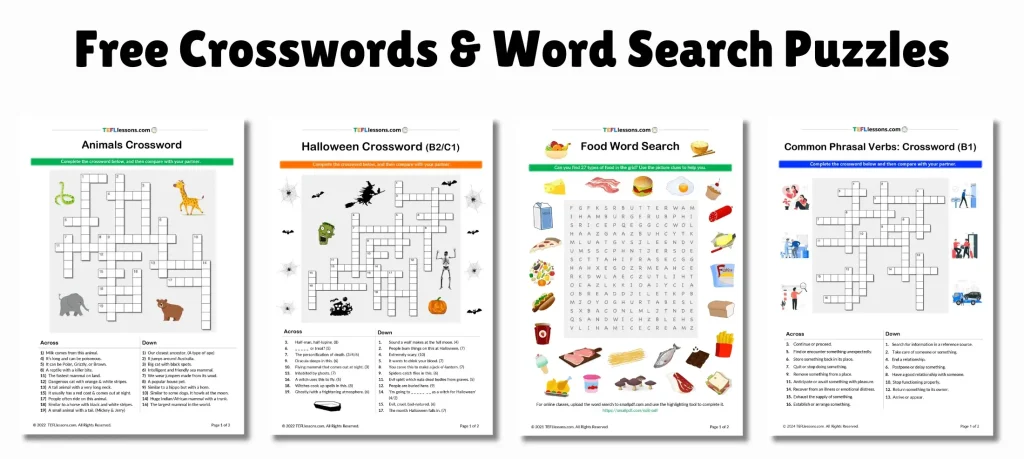Looking for fun ESL activities that can engage students while helping them improve their English skills?
Here, you will find a comprehensive list of over 100 fun ESL activities for learners of all ages and levels. These interactive games and creative exercises make learning English enjoyable and effective, whether you’re teaching online, in a classroom, or tutoring one-on-one.
1. 20 Questions
One student thinks of an object, and the rest of the class asks yes/no questions to guess what it is, encouraging both speaking and critical thinking.
2. Pictionary
A drawing game where students illustrate vocabulary words, and their teammates guess the word. Among the top fun ESL activities, Pictionary encourages students to illustrate vocabulary words, and their teammates guess the word, making learning visual and interactive.
3. Odd One Out
Provide students with groups of words, and they must identify which one doesn’t belong and explain why, encouraging critical thinking and vocabulary practice.
4. Running Dictation
Place a text on one side of the room. One student runs to read it, returns to their partner, and dictates it. Their partner writes it down, encouraging teamwork, listening, and writing skills.
5. Memory Game
Create a set of vocabulary or picture cards, and students take turns flipping over two cards to find matching pairs, boosting vocabulary retention.

There’s no shortage of fun ESL activities to explore! Be sure to bookmark this list and revisit whenever you need fresh, effective lesson ideas.
6. Survey/Questionnaire
Have students create and conduct surveys with their classmates, collecting data to practice speaking, listening, and writing skills.
7. Story Cubes
Use dice with pictures (or Story Cubes) to prompt students to create a story, improving creativity and narrative skills.
8. Error Correction Relay
Divide the class into teams. Give each team a sentence with mistakes, and they must race to correct it. The team that finishes correctly first wins.
9. Hot Seat
One student sits with their back to the board while the teacher writes a word behind them. Their classmates give clues to help them guess the word, practicing speaking and vocabulary.
10. Chain Story
Each student adds a sentence to build a story, focusing on coherence and narrative flow while practicing sentence structure and creativity.
11. Fill in the Blanks
Provide sentences or paragraphs with missing words, and students fill in the blanks using the appropriate vocabulary or grammar.
12. Dictogloss
Read a short text at normal speed. Students listen and take notes, then reconstruct the text as accurately as possible, practicing listening and writing.
13. Word Jumble Race
Divide students into teams and give them scrambled words. They race to put the words in the correct order to form sentences.
Teaching doesn’t have to be repetitive — use these fun ESL activities to bring variety and energy into every class session.

Looking for more fun ESL activities?
Keep scrolling—we’ve got plenty more to keep your lessons lively and effective!
14. Find the Differences
Give students two similar pictures and have them describe the differences to each other, practicing descriptive language and attention to detail.
15. What Am I?
One student describes an object, place, or person without naming it, and others must guess what it is, encouraging vocabulary use and speaking.
16. Song Lyrics Gap Fill
Play a song and provide students with the lyrics, leaving certain words blank. Students listen and fill in the missing words, practicing listening and vocabulary.
17. Vocabulary Auction
Give students fake money and have them “buy” words to use in sentences. The goal is to use the words correctly in context, making learning competitive and engaging.
18. Speed Writing
Give students a topic, set a timer, and have them write as much as they can in a short time. This encourages fluency and creative thinking.
Don’t forget! Switching between different fun ESL activities helps students build new skills and prevents classroom burnout.
19. Describe and Draw
One student describes a picture, and the other student must draw it based only on the description, practicing speaking and listening skills.
20. Word Bingo
Create Bingo cards with vocabulary words. Call out definitions or examples, and students mark off the correct word, reinforcing vocabulary.
21. Tongue Twisters
Use tongue twisters to help students practice pronunciation and fluency, especially focusing on difficult sounds.
22. PechaKucha
Students give quick presentations with a set number of slides (usually 20 slides shown for 20 seconds each), helping them practice concise speaking.
23. Sentence Starters
Give students sentence beginnings; they must complete them with their own ideas, practicing sentence structure and creativity.
24. Dictation Race
Write a passage on the board, but remove keywords. Students must run to the board, memorize a portion, run back to their group, and fill in the blanks.
You’re almost there! Keep going and discover even more fun ESL activities to energize your classroom.
25. Fact or Fiction
Students write down several statements, some true and some false. Classmates must guess which ones are true, practicing speaking and critical thinking.
26. Back to the Board
Similar to “Hot Seat,” one student faces away from the board while the teacher writes a word. Classmates give clues to help them guess the word, practicing speaking.
Whether you teach kids, teens, or adults, these fun ESL activities can be adapted to any level and learning style. Explore more below!
27. Who Am I?
Students stick a name or picture of a famous person to each other’s backs. They must ask yes/no questions to figure out who they are, practicing questioning and listening.
28. Word Ladders
Give students a starting word and a target word. They must change one letter at a time to form new words until they reach the target word, practicing vocabulary and spelling.
29. Sentence Completion Relay
Divide students into teams. Each team member must write one word to complete a sentence. The team with the most correct and creative sentences wins.
30. Board Race
Divide the class into two teams. Ask a question or give a prompt, and one member from each team races to the board to write the correct answer first.
31. Grammar Auction
Give students sentences with intentional grammar mistakes. They bid on the sentences they believe are correct. Afterward, correct the sentences and see who made the best purchases.
32. Word Hunt
Hide vocabulary words around the classroom. Students must find them and then use each word in a sentence to demonstrate understanding.
33. Category Game
Provide students with a category (e.g., fruits, animals). They take turns listing items in that category. The first to repeat an answer or hesitate loses.
ESL classrooms should be engaging and global. These fun ESL activities help students connect, collaborate, and communicate — all while having fun.

With these fun ESL activities, you’ll have no shortage of creative ways to get your students excited about learning English. Whether you’re focused on speaking, grammar, or vocabulary, there’s something here for every lesson plan.
34. Picture Prompt Writing
Provide a picture and ask students to write a story or description based on the image, encouraging creative writing and descriptive language.
35. Guess the Job
Give clues about a job, and students must guess which profession you’re describing, practicing vocabulary related to jobs and work.
36. Quick Fire Grammar Quiz
Ask rapid-fire grammar questions, and students must answer as quickly as possible, reinforcing grammar knowledge in a fun way.
37. Guess My Word
Give clues to a vocabulary word, and students must guess the word, practicing vocabulary recall and critical thinking.
38. Running Questions
Post questions or tasks around the room. Students move from one to the next, answering questions on a worksheet or discussing the answers with a partner.
39. Guess the Sound
Play sound clips, and students guess what they are, practicing listening skills and vocabulary.
40. Cultural Exchange
Have students present on aspects of their own culture, encouraging speaking and cultural awareness.
41. Picture Story
Show students a series of pictures and ask them to create a story based on the images. This builds creativity, speaking, and narrative skills.
Teaching tip: Rotate a few of these fun ESL activities into your weekly lessons to keep things fresh and exciting — your students will thank you!
42. Two Truths and a Lie
Each student tells two truths and one lie about themselves. The class guesses which statement is the lie, practicing speaking, listening, and critical thinking.
43. Word Chain
Start with a word, and the next student must say a word that starts with the last letter of the previous word, building vocabulary and fluency.
44. Ball Toss Questions
Toss a softball around while music plays. When the music stops, the student holding the ball must answer a question, promoting active participation.
45. Spelling Bee
Have students spell words aloud in a competition format, building confidence in spelling and pronunciation.
46. Silent Conversation
Pair up students and give them a topic. They “converse” by writing notes to each other, and practising writing and reading skills.
47. Same or Different
Show students pairs of similar pictures. They must identify what’s the same and what’s different, practicing observation, speaking, and descriptive language.
48. Guess the Word
Write a word on a piece of paper and show it to one student without letting others see it. They must describe the word to the class, who tries to guess what it is.
49. Whisper Chain
One student whispers a sentence to another, who passes it down the line. The last student says it aloud, and the class sees how much the sentence has changed, practicing listening.
50. Would You Rather?
Ask students “Would you rather…?” questions, prompting them to choose and explain their preference, encouraging speaking and reasoning.
51. Spot the Mistake
Write a sentence with a deliberate grammar or spelling mistake on the board. Students must find and correct the error, reinforcing grammar rules.
52. Who Said It?
Provide quotes from famous people or characters, and students must guess who said it, practicing listening and comprehension.
53. Flash Writing
Give students a word or prompt and set a timer. They write as much as they can in the time limit, encouraging fluency in writing.
54. Newspaper Article Review
Give students a short newspaper article to read. They then summarize it in their own words, practicing reading comprehension and summarization.
55. Grammar Charades
Students act out grammatical structures (e.g., present continuous or future tense) while others guess the structure, practicing grammar in a fun way.
56. Emoji Stories
Show students a series of emojis and have them create a story based on the emoji sequence, encouraging creativity and narrative skills.
57. Sentence Race
In groups, students race to write a correct sentence using given words, practicing grammar and sentence structure.
58. Grammar Basketball
Ask grammar questions. If students answer correctly, they get a chance to shoot a ball into a basket (real or improvised), making learning competitive and fun.
59. Prediction Game
Give students a scenario and ask them to predict what happens next, encouraging critical thinking and future tense practice.
60. Grammar Matching
Provide sentences with grammatical structures, and students match them to the correct grammar rules, reinforcing grammar understanding.
61. Alphabet Race
Choose a category (e.g., animals, food). Students race to write down a word for each letter of the alphabet in that category, reinforcing vocabulary.
62. Create a Comic Strip
Students create a comic strip to tell a short story, practicing narrative writing, creativity, and sentence structure.
63. Rhyme Time
Provide a word, and students must come up with as many rhyming words as they can, practicing phonics and vocabulary.
64. Create a Travel Brochure
Students create a brochure for a real or imaginary destination, practicing descriptive writing and persuasive language.
65. Silent Reading and Reflection
Students read a text silently and write a short reflection or summary afterward, practicing reading comprehension and writing.

This list of fun ESL activities is perfect for spicing up your lesson plans and keeping students engaged. Try a few each week and watch your classroom participation soar!
66. Group Discussions
Organize students into small groups to discuss a topic, encouraging conversation and collaboration.
67. Debate
Students prepare and present arguments for or against a topic, developing critical thinking and public speaking skills.
68. Role Play
Students act out scenarios (e.g., at a restaurant, job interview), practicing conversational skills and vocabulary relevant to the situation.
69. Sentence Scramble
Provide a mixed-up sentence that students must rearrange to make it correct, reinforcing sentence structure.
70. Cloze Activity
Create a text with missing words, and students fill in the blanks with the appropriate vocabulary or grammar.
71. Scavenger Hunt
Create a list of vocabulary words, and students must find or draw items that match the words, reinforcing vocabulary through engagement.
72. Timelines
Have students create timelines of historical events or personal life events, practicing past tense and sequencing.
73. Interview a Classmate
Students prepare questions and interview each other, practicing question formation and conversational skills.
74. Cultural Presentations
Students research and present on different cultures, promoting cultural awareness and presentation skills.
75. Draw and Describe
One student draws a picture without showing it to others. They must describe it while others attempt to replicate it, practicing descriptive language.
76. Sentence Transformation
Provide a sentence and ask students to transform it (e.g., change it from active to passive voice), reinforcing grammar.
77. Reading Aloud
Have students take turns reading passages aloud, and practising pronunciation and intonation.
78. Mystery Word
Students are given clues to guess a word, encouraging vocabulary recall and reasoning skills.
79. Collaborative Story Writing
Students work in groups to write a story, taking turns adding sentences, fostering teamwork and creativity.
80. Descriptive Writing Prompts
Provide prompts that require students to write detailed descriptions, enhancing their descriptive language skills.
81. Letter Writing
Have students write letters to friends or family members, practicing formal and informal writing styles.
82. Classroom Debate
Organize a formal debate on a relevant topic, promoting critical thinking and public speaking skills.
83. Story Time
Read a short story and have students discuss the characters, plot, and their opinions, encouraging comprehension and expression.
84. Peer Teaching
Have students teach each other vocabulary or grammar points, reinforcing their understanding while practicing speaking.
85. Create a Recipe
Students write a recipe for their favorite dish, practicing imperative verbs and descriptive language.
Keeping students motivated takes more than just a worksheet. That’s why these fun ESL activities are designed to be interactive, creative, and memorable.
86. Word of the Day
Introduce a new word each day and have students use it in sentences throughout the day, reinforcing vocabulary acquisition.
87. Hot Potato
Pass a ball around while music plays. When the music stops, the student holding the ball must answer a question, promoting active participation.
88. Teach a Phrase
Each student teaches a phrase or idiom they know to the class, promoting sharing and expanding vocabulary.
89. Role Reversal
Have students take turns being the teacher and explaining a topic or grammar point to the class, enhancing understanding.
90. Interactive Vocabulary Wall
Create a wall where students can add new vocabulary words and definitions as they learn them, fostering ongoing vocabulary practice.
91. Personal Vocabulary Books
Have students maintain a personal vocabulary book where they write new words, definitions, and example sentences, reinforcing retention.
92. Cultural Comparisons
Students research and compare cultural norms, traditions, or holidays from different countries, enhancing cross-cultural understanding.
93. Mystery Box
Fill a box with items related to vocabulary words. Students pick an item and describe it, practicing descriptive language and vocabulary.
94. Team Challenges
Create challenges where students work in teams to solve language puzzles or complete tasks, promoting collaboration and engagement.
95. Personalized Flashcards
Have students create their own flashcards for vocabulary words, which they can use for practice with classmates.
96. Collaborative Art Projects
Students create an art piece related to a theme or vocabulary set, integrating creativity with language learning.
97. Pronunciation Drills
Focus on specific sounds or syllable patterns through repeated drills to improve students’ pronunciation skills.
98. Kahoot Quizzes
Use Kahoot to create fun quizzes that students can answer on their devices, reinforcing vocabulary and grammar interactively.
99. Interactive Whiteboard Activities
Use technology to create interactive lessons where students can engage with vocabulary and grammar exercises on a smartboard.
Still with us? Great! You’re just steps away from mastering 100+ fun ESL activities your students will love.
100. Monthly Themes
Each month, focus on a specific theme (e.g., travel, food) and incorporate vocabulary and fun ESL activities related to that theme.
101. Listening Journals
Students maintain a journal where they summarize what they hear in English podcasts or videos, enhancing listening skills.
102. Interview a Guest Speaker
Invite someone from a different background to talk to the class, providing real-world context and practicing listening skills.
103. Role-Playing Scenarios
Create real-life scenarios (e.g., ordering food, making a phone call) for students to role-play, enhancing practical speaking skills.
104. Book Club
Organize a book club where students read and discuss books in English, promoting reading comprehension and critical thinking.
105. Interactive Games
Incorporate educational games that require language use (like Scrabble or Taboo) to make learning fun and engaging.
106. Show and Tell
Have students bring an item from home to show and tell about it, encouraging speaking practice and personal expression.
107. Crossword Puzzles
Create crossword puzzles using vocabulary words from recent lessons, reinforcing vocabulary and spelling.
108. Classroom Displays
Have students create displays or posters about a topic, practicing their writing and presenting skills.
109. Feedback Sessions
Students give feedback on each other’s speaking or writing, promoting peer learning and constructive criticism.
110. Language Learning Apps
Introduce students to language learning apps that they can use for practice outside of class, reinforcing learning through technology.
With these fun ESL activities, you’ll never run out of creative ways to make your lessons more interactive, engaging, and effective. Whether you’re focusing on grammar, vocabulary, speaking, or listening, incorporating variety keeps students motivated and excited to learn. These activities are flexible enough to use in classrooms, online settings, or one-on-one tutoring.
Start adding a few of these fun ESL activities into your weekly lessons and see how they boost student participation, confidence, and overall language development.
Want more? Don’t forget to explore our full collection of free ESL materials to expand your toolkit even further.
Search for Fun ESL Activities below:
For the best printing results when using our ESL PDFs, we recommend using Adobe Acrobat (free).


